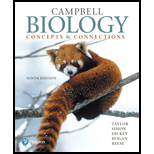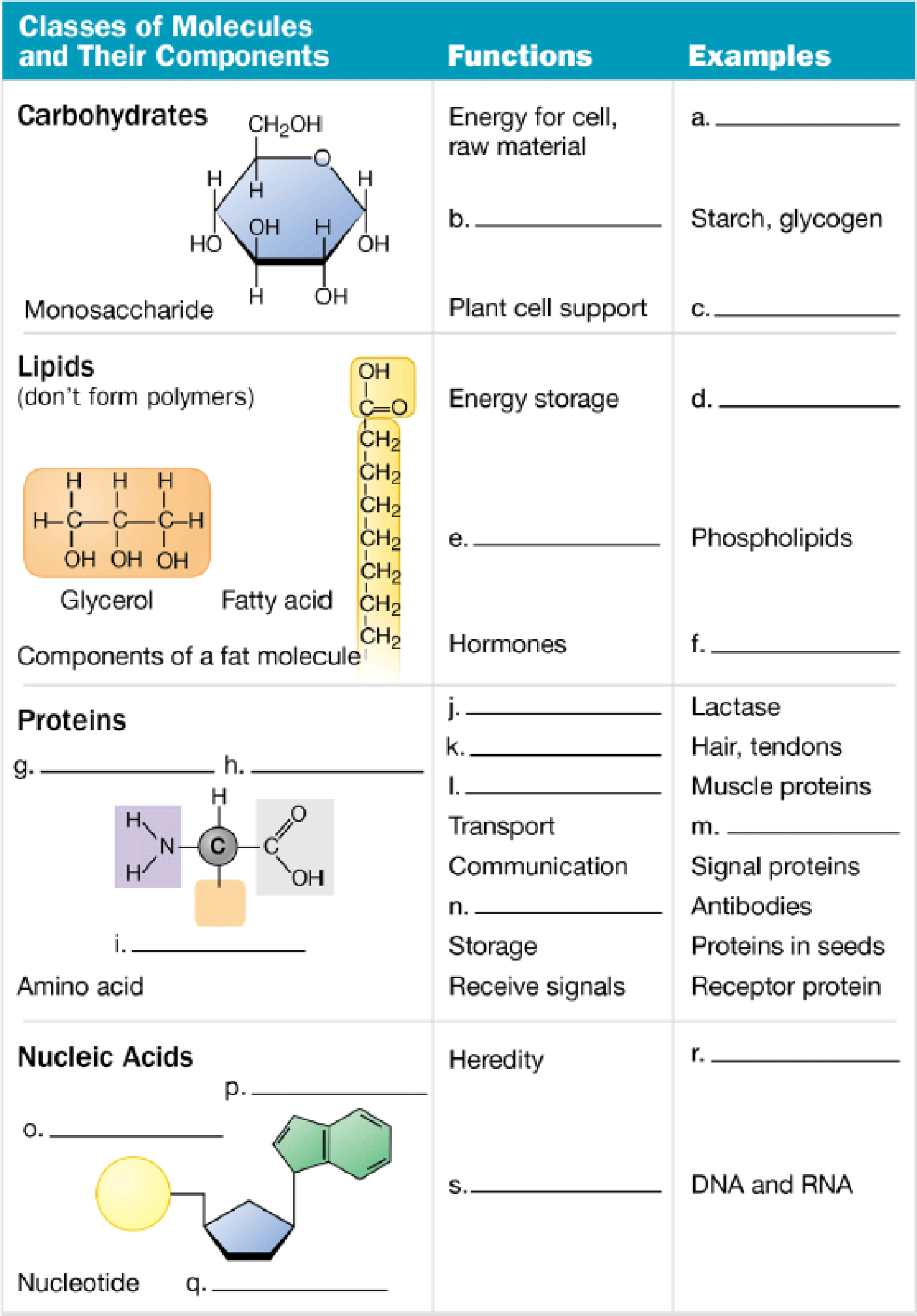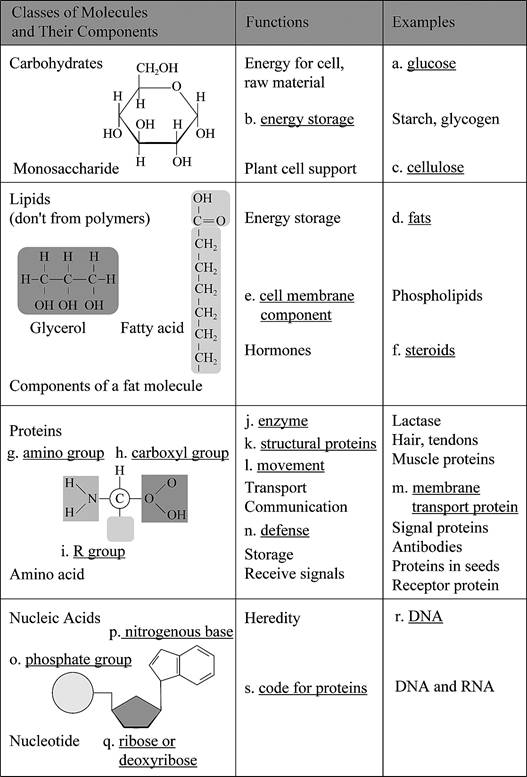
Concept explainers
Complete the following table to help you review the structures and functions of the four classes of organic molecules.

To create: The concept map to review the structures and functions of the four classes of organic molecules.
Introduction: The four classes of molecules such as carbohydrates, lipids, proteins, and nucleic acids are important to sustain the life. Carbohydrates serve as a fuel and building material for cellsand tissues. Lipid comprises a diverse group of molecules. It does not mix with water. A protein is a polymer of amino acids. It is structurally and functionally most complex and varied. Nucleic acid is the genetic material that consists of a polynucleotide.
Answer to Problem 1CC
Pictorial representation: Fig. 1 shows the completed concept map of structures and functions of the four classes of organic molecules.

Fig.1: Concept map of the structures and functions of the four classes of organic molecules.
Explanation of Solution
a.
Correct answer: Glucose
Explanation: Glucose is the raw material from which cell will get energy. Hence, the correct answer is Glucose.
b.
Correct answer: Energy storage
Explanation: The starch and glycogen is used as storage material of energy. Hence, the correct answer is energy storage.
c.
Correct answer: Cellulose
Explanation: Cellulose is polysaccharides which is a polymer of glucose molecule. Hence, the correct answer is cellulose.
d.
Correct answer: Fats
Explanation: Fats are a type of lipid. It is composed of glycerol and fatty acids. Hence, the correct answer is fats.
e.
Correct answer: Cell membrane component
Explanation: Cell is the outermost boundary of animal cell. It is made of phospholipid bilayer. Hence, the correct answer is cell membrane component.
f.
Correct answer: Steroids
Explanation: Steroids are hormones such as estrogen. Hence, the correct answer is steroids.
g.
Correct answer: Amino group
Explanation: Protein is made of amino acids. An amino acid contains amino group which is
h.
Correct answer: Carboxylic group
Explanation: Protein is made of amino acids. An amino acid contains carboxylic group which is
i.
Correct answer: R group
Explanation: Protein is made of amino acids. An amino acid contains a side group which is called R group. Hence, the correct answer is R group.
j.
Correct answer: Enzyme
Explanation: Proteins have broad functions such as enzymes, structural proteins, transport, movement, defense, and storage. Lactase is an enzyme used for breakdown of lactose molecule. Hence, the correct answer is Enzyme.
k.
Correct answer: Structural proteins
Explanation: Proteins have broad functions such as enzymes, structural proteins, transport, movement, defense, and storage. Hair and tendons are structural proteins. Hence, the correct answer is structural proteins.
l.
Correct answer: Movement
Explanation: Muscle is a protein that helps in movement. Hence, the correct answer is movement.
m.
Correct answer: Membrane transport protein
Explanation: Membrane transport protein helps in transport of different molecules across the membrane. Hence, the correct answer is Membrane transport protein.
n.
Correct answer: Defense
Explanation: Signal protein helps in communication. Antibodies are immunoglobulin protein that helps in body defense. Hence, the correct answer is defense.
o.
Correct answer: Phosphate group
Explanation: Nucleic acid is a polymer of nucleotides. A nucleotide consists of phosphate group, sugar and nitrogenous base. Hence, the correct answer is phosphate group.
p.
Correct answer: Nitrogenous base
Explanation: Nucleic acid is a polymer of nucleotides. A nucleotide consists of phosphate group, sugar and nitrogenous base. Hence, the correct answer is nitrogenous base.
q.
Correct answer: Ribose or deoxyribose
Explanation: Nucleic acid is a polymer of nucleotides. A nucleotide consists of phosphate group, sugar (ribose or deoxyribose) and nitrogenous base. Hence, the correct answer is ribose or deoxyribose.
r.
Correct answer: DNA
Explanation: Nucleic acid is a polymer of nucleotides. DNA (deoxyribonucleic acid) is the hereditary material. Hence, the correct answer is DNA.
s.
Correct answer: Code for protein
Explanation: Nucleic acid is a polymer of nucleotides. DNA and RNA have information to code for protein. Hence, the correct answer is code for protein.
Want to see more full solutions like this?
Chapter 3 Solutions
Campbell Biology: Concepts & Connections (9th Edition)
- Amino Acid Coclow TABle 3' Gly Phe Leu (G) (F) (L) 3- Val (V) Arg (R) Ser (S) Ala (A) Lys (K) CAG G Glu Asp (E) (D) Ser (S) CCCAGUCAGUCAGUCAG 0204 C U A G C Asn (N) G 4 A AGU C GU (5) AC C UGA A G5 C CUGACUGACUGACUGAC Thr (T) Met (M) lle £€ (1) U 4 G Tyr Σε (Y) U Cys (C) C A G Trp (W) 3' U C A Leu בוט His Pro (P) ££ (H) Gin (Q) Arg 흐름 (R) (L) Start Stop 8. Transcription and Translation Practice: (Video 10-1 and 10-2) A. Below is the sense strand of a DNA gene. Using the sense strand, create the antisense DNA strand and label the 5' and 3' ends. B. Use the antisense strand that you create in part A as a template to create the mRNA transcript of the gene and label the 5' and 3' ends. C. Translate the mRNA you produced in part B into the polypeptide sequence making sure to follow all the rules of translation. 5'-AGCATGACTAATAGTTGTTGAGCTGTC-3' (sense strand) 4arrow_forwardWhat is the structure and function of Eukaryotic cells, including their organelles? How are Eukaryotic cells different than Prokaryotic cells, in terms of evolution which form of the cell might have came first? How do Eukaryotic cells become malignant (cancerous)?arrow_forwardWhat are the roles of DNA and proteins inside of the cell? What are the building blocks or molecular components of the DNA and proteins? How are proteins produced within the cell? What connection is there between DNA, proteins, and the cell cycle? What is the relationship between DNA, proteins, and Cancer?arrow_forward
- please fill in the empty sports, thank you!arrow_forwardIn one paragraph show how atoms and they're structure are related to the structure of dna and proteins. Talk about what atoms are. what they're made of, why chemical bonding is important to DNA?arrow_forwardWhat are the structure and properties of atoms and chemical bonds (especially how they relate to DNA and proteins).arrow_forward
- The Sentinel Cell: Nature’s Answer to Cancer?arrow_forwardMolecular Biology Question You are working to characterize a novel protein in mice. Analysis shows that high levels of the primary transcript that codes for this protein are found in tissue from the brain, muscle, liver, and pancreas. However, an antibody that recognizes the C-terminal portion of the protein indicates that the protein is present in brain, muscle, and liver, but not in the pancreas. What is the most likely explanation for this result?arrow_forwardMolecular Biology Explain/discuss how “slow stop” and “quick/fast stop” mutants wereused to identify different protein involved in DNA replication in E. coli.arrow_forward
 Biology Today and Tomorrow without Physiology (Mi...BiologyISBN:9781305117396Author:Cecie Starr, Christine Evers, Lisa StarrPublisher:Cengage Learning
Biology Today and Tomorrow without Physiology (Mi...BiologyISBN:9781305117396Author:Cecie Starr, Christine Evers, Lisa StarrPublisher:Cengage Learning Human Biology (MindTap Course List)BiologyISBN:9781305112100Author:Cecie Starr, Beverly McMillanPublisher:Cengage Learning
Human Biology (MindTap Course List)BiologyISBN:9781305112100Author:Cecie Starr, Beverly McMillanPublisher:Cengage Learning Concepts of BiologyBiologyISBN:9781938168116Author:Samantha Fowler, Rebecca Roush, James WisePublisher:OpenStax College
Concepts of BiologyBiologyISBN:9781938168116Author:Samantha Fowler, Rebecca Roush, James WisePublisher:OpenStax College Biology (MindTap Course List)BiologyISBN:9781337392938Author:Eldra Solomon, Charles Martin, Diana W. Martin, Linda R. BergPublisher:Cengage Learning
Biology (MindTap Course List)BiologyISBN:9781337392938Author:Eldra Solomon, Charles Martin, Diana W. Martin, Linda R. BergPublisher:Cengage Learning Anatomy & PhysiologyBiologyISBN:9781938168130Author:Kelly A. Young, James A. Wise, Peter DeSaix, Dean H. Kruse, Brandon Poe, Eddie Johnson, Jody E. Johnson, Oksana Korol, J. Gordon Betts, Mark WomblePublisher:OpenStax College
Anatomy & PhysiologyBiologyISBN:9781938168130Author:Kelly A. Young, James A. Wise, Peter DeSaix, Dean H. Kruse, Brandon Poe, Eddie Johnson, Jody E. Johnson, Oksana Korol, J. Gordon Betts, Mark WomblePublisher:OpenStax College





